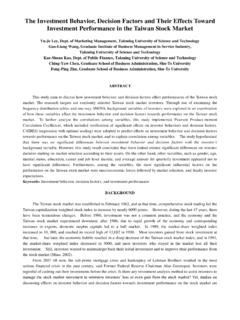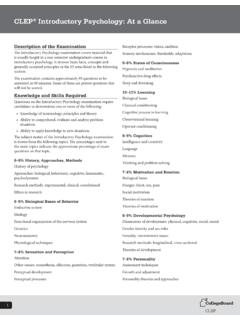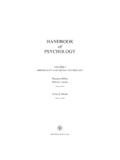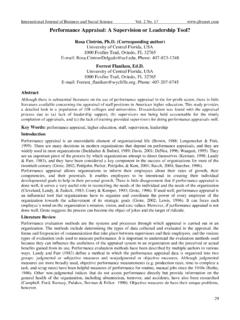Transcription of MEdia EffEcts - World Bank
1 MEdia EffEcts | CommGAP MEdia EffEctsDefining MEdia EffectsMost people accept the idea that the MEdia can influence people. But the degree of that influence, as well as who is most-impacted, when, how and why, have been the subjects of great debate among commu-nication scholars for nearly a century. MEdia EffEcts refers to the many ways individuals and society may be influenced by both news and entertainment mass MEdia , including film, television, radio, newspapers, books, magazines, websites, video games, and for Evidence of the MEdia s ImpactMedia EffEcts have been studied by scholars in communication, psychology, sociology, political science, anthropology, and education, among other fields. Many early communication models designed to explain the process of message dissemination were simple, one-way, and linear (Shannon & Weaver, 1949), posi-tioning the medium or message as the cause and the behavioral, emotional, or psychological response as the effect (Bryant & Thompson, 2002, pp.)
2 4 5). Modern conceptualizations, however, typically illustrate a two-way process that is more transactional or interactive in nature, in which the message or the medium affects the recipient(s), but the audience, in turn, influences and shapes the sender(s). In the early part of the 20th century, concerns about political propaganda, manipulation by the elite and the rising popularity of electronic MEdia led to the so-called hypodermic needle or bullet theories, which envisaged MEdia messages as strong drugs or potent weapons that would have powerful EffEcts on a helpless audience (Lasswell, 1927; Lippmann, 1922). However, while these theories explained some behavior, they did not account for the different responses individuals may have to the same MEdia source.
3 In the 1950 s and 60 s, empirical research began to uncover the moderating power of predispositions and peer groups, concluding that the MEdia s impact was small often referred to as limited EffEcts theory (Klapper, 1960; Lazarsfeld, Berelson, & Gaudet, 1944). In the 1970 s and 80 s, prominent scholars began to look more closely again at the MEdia s relationship to knowledge, opinion, attitudes, and levels of vio-lence, concluding that MEdia EffEcts could be significant in some cases, even if not all powerful. Scholars also came to agree that some vulnerable groups, such as children, may be more heavily influenced by MEdia than others (Bryant & Thompson, 2002; McCombs & Shaw, 1972; McLuhan, 1964). One great difficulty for researchers is how to measure MEdia EffEcts .
4 MEdia consumption may affect a person s thoughts, emotions, or behaviors in ways that could be direct or indirect, immediate or delayed, fleeting or lasting. It is impossible for scientists to control for all of the mediating factors, from levels of MEdia consumption to demographics such as age, race, and socioeconomic status to harder-to-measure variables like environment, upbringing, values and previous experience. A researcher would not be able to prove, for example, that playing a violent video game caused a person to commit a violent crime, even if an association existed between the two behaviors. Did playing the game lead to the violent behavior, or did a propensity toward violence encourage use of the game? Why didn t all individuals who played the game commit acts of violence?
5 Traditional methods of research such as surveys, experiments, and panel studies cannot adequately solve this cause-and- effect EffEcts | CommGAP | 2 Passive Versus Active MEdia ConsumptionTo understand MEdia EffEcts , it is first critical to consider how MEdia are used and for what purposes. Communication scholars have traditionally fallen into two camps functionalists, who believe the MEdia audience tends to be in control and active, and critical/culturalists who believe the audience has less control and is therefore more passive. The balance may lie somewhere in the middle and may vary from country to than concerning itself with what the MEdia does to people, Uses and Gratifications Theory looks at what people do with MEdia (its functions), positing that individuals actively choose the MEdia they use and do so with specific goals in mind (Blumler & Katz, 1974).
6 These goals or gratifications may be different for different people and can include entertainment, information, relief of boredom or escapism, introspec-tion or insight, finding models for behavior, seeking reinforcement for beliefs or values, serving as a basis for conversation and social interaction, helping to either identify with others or to avoid interactions with them, and so on (McQuail, 2005). Functionalists emphasize the audience s cognitions and scholars believe Uses and Gratifications Theory fails to account for socio-cultural factors. First, they take issue with the assumption that open and active MEdia choices are available to all individu-als. Secondly, they believe the functionalist approach may minimize the impact of the dominant cultural or transnational power(s) in presenting choices that serve to reinforce existing elites.
7 An additional concern is that if we accept the idea that people are neither coerced nor manipulated and have full control over their MEdia consumption choices, policy makers may tend to be less attentive to and critical of MEdia con-tent and power (Morley, 2006). MEdia EffEcts and Our View of the WorldWhile discussion of MEdia EffEcts often centers on dramatic issues such as violence or propaganda, schol-ars have identified a number of more subtle potential EffEcts : Priming MEdia messages may stimulate recall of stored ideas, knowledge, opinions, or experience associated in some way with the message content. For example, a news story about the French presi-dential election might trigger thoughts about the French economy, memories of a trip to Paris during college, or remind a person to put brie on their grocery list (Fiske & Taylor, 1991).
8 Agenda-Setting The MEdia may not affect what people think, but may affect what they think about, through the choice of which topics to cover and what to emphasize. Control of the flow of infor-mation is often referred to as gatekeeping, and is based not only on MEdia professionals perceptions of what is important, but also on time and space limitations (Cohen, 1963; Lippmann, 1922). Framing Frames are the particular treatment or spin an individual or organization gives to a mes-sage (Gitlin, 1980). While agenda-setting is choosing which stories to tell, framing is choosing how to tell them. Frames may promote a particular problem definition, causal interpretation, moral evalua-tion, and/or treatment recommendation (Entman, 1993, p.)
9 54). Cultivation Over time, heavy viewers of television may come to believe that the real World is similar to the television World heavy exposure to the MEdia cultivates this belief (Gerbner, Gross, Signorielli, & Morgan, 1980). For example, based on the proportion among television characters, a heavy user of television might estimate that more than one in ten males hold jobs in law enforcement, when in reality only 1 in 100 do (Dominick, 2005, p. 471). Researchers have been particularly concerned with cultiva-tion s impact on racial, ethnic, and gender stereotypes as well as attitudes about to cultivation, there are several other important terms in the MEdia EffEcts vocabulary: Mainstreaming Heavy television viewers may lose the attitudes, beliefs or customs of their cultures in favor of those they see repetitively on television (Bryant & Thompson, 2002).
10 Disinhibitory effect MEdia s ability to desensitize people to socially unacceptable behavior, mak-ing it either acceptable or desirable. The disinhibitory effect may enable people to rationalize or justify MEdia EffEcts | CommGAP | 3actions that conflict with their internal code of conduct or morality (Bryant & Thompson, 2002). Early research on this effect exposed preschoolers to a film in which adults took out their aggression on an inflatable punching bag clown ( Bobo ); children who saw the film later imitated it and also engaged in other violent behavior not seen on the film (Bandura, Ross, & Ross, 1963). Mean World Syndrome MEdia consumers may become so overwhelmed by negative portrayals of crime and violence that they may begin either cynically or despondently to believe the real World is a mean and harsh place (Gerbner, Gross, Jackson-Beeck, Jeffries-Fox, & Signorielli, 1978; Wilkinson & Fletcher, 1995).
















